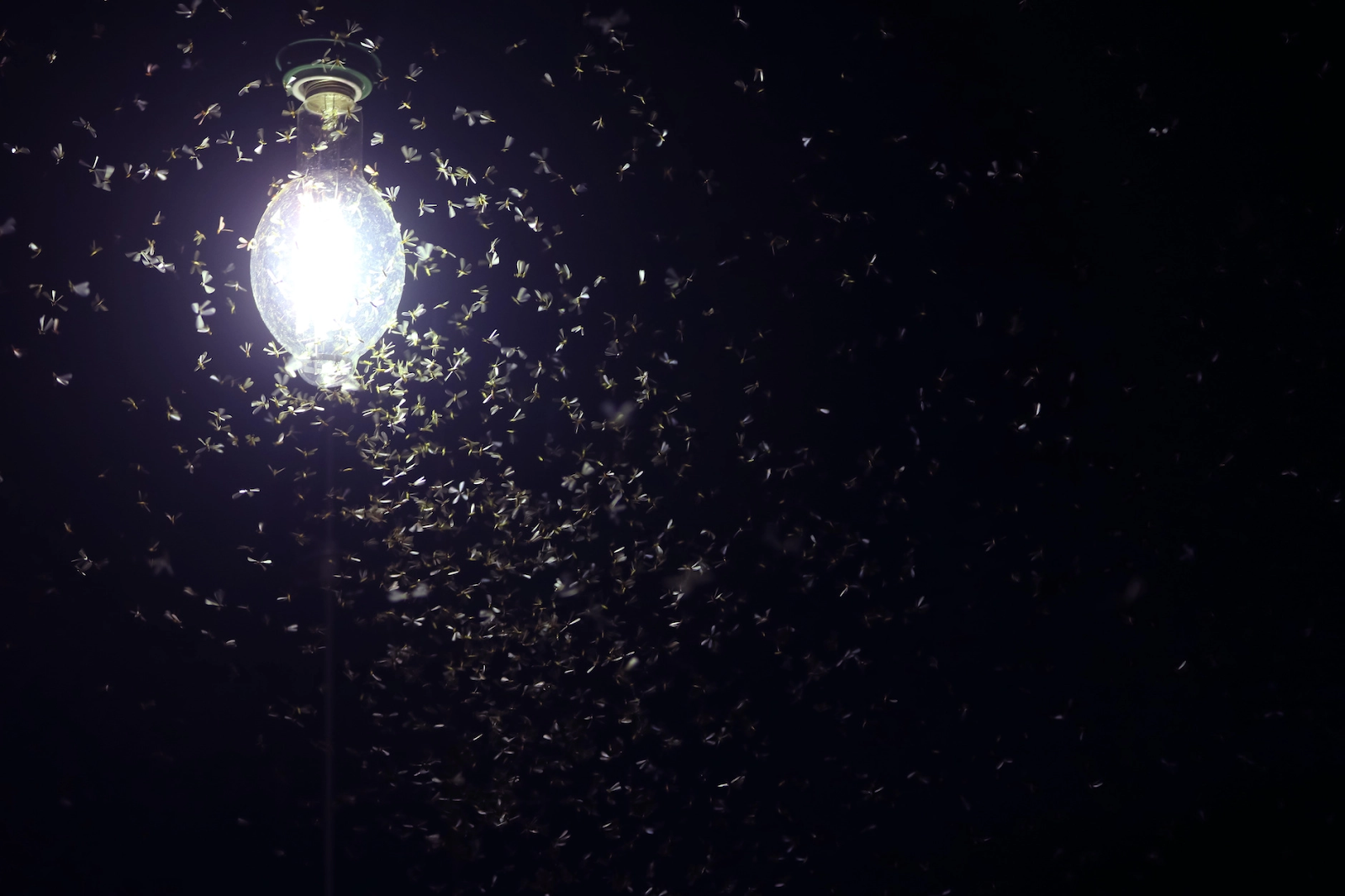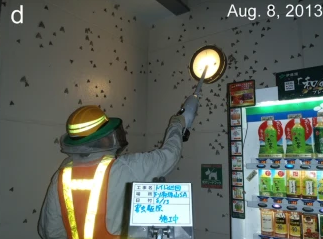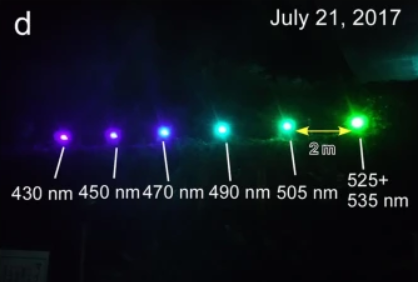Why are insects attracted to light?
We often see insects buzzing around light fixtures outside, or find their remains in light fixtures when replacing a lightbulb. However, seldom we wonder why they are so attracted to light. The photo below shows insects buzzing around an outdoor light bulb. Bugs that are attracted to these porch lights are called positively phototactic, examples include moths and flies. In the word “phototactic”, “Photo” means light, and “taxis” means movement of an organism towards a stimulus. Conversely, insect species such as cockroaches are repelled by light and are called negatively phototactic. In this blog post we will explore a couple of studies that show a big promise of using LED based insect traps to control the insect population.

Positively Phototactic Insects Attracted to a Bright Light during Night. Photo Courtesy of Farmers Almanac
There are multiple theories on why swarms tend to be attracted to artificial lights. One is that insects use the moon to navigate, and they therefore travel towards bright lights. The other theory is a survival technique. When, for example, an insect is being attacked inside a cave, they will fly towards the safety of light from the cave opening. According to either theory, insects see the light as a safe source to fly towards.
Humans see just bright, white light coming from a bulb; however, insects see it a bit differently. Humans can only see in the visible spectrum, which ranges from 400 nanometers to 700 nanometers. Insects see parts of the visible spectrum and ultraviolet light, from about 300 nanometers to 600 nanometers. This is why insects are generally more attracted to blue/UV lights, over warmer colored lights such as yellow or red. For the common house fly, the photoreceptors in their eyes are most sensitive to about 350 nanometers. Thus LEDs which emit visible light and UV light are good fly traps, since they attract flies, while also acting as outdoor lighting.
In several studies discussed below, multiple different colors and types of light are tested to measure insect attraction. These results were performed with the goal of better controlling insect populations.
Red Pumpkin Beetles in Nigeria
At Federal University Wukari in Nigeria, a team from the Department of Biological Studies tested how red pumpkin beetles react to different wavelengths of light. They discuss this in a paper titled, “Flight to Light Response of Red Pumpkin Beetle (Aulacophora africana Weise) to Differently Colored Light-emitting Diode and Incandescent Bulb Lights”.
Red pumpkin beetles are deleterious to crops. They not only eat away at them, but also spread diseases. Usually to control this species, insecticides are used. However, these are harmful to both humans and the environment. The point of this study was to find which lights best control these beetles. Since these bugs are positively phototactic, the researchers tested their attraction to specific light wavelengths. Both Light Emitting Diodes and Incandescent lights were tested. Red, yellow, green, blue, and white colors were tested for each type of light.
The light was emitted onto a two meter white polyethylene screen. The six light traps, which consisted of the five colors and a control group, were placed outside for six hours. Beetles attracted to the light were collected and counted. For the LED lights, the beetles were most attracted to the blue light, while least attracted to the red light. For the incandescent bulbs, the beetles were most attracted to the white light, and, like the LEDs, least attracted to red light. Based on these results, white incandescent bulbs and blue LEDs could be used around the farms that attract red pumpkin beetles. This may help decrease the crops lost due to these insects.
Controlling gypsy moths in Japan through LED based insect traps
Another similar study was performed miles away from these red pumpkin beetles, in Japan. Instead of damaging crops, insects are a nuisance to the local human population and ecosystem. Expressway rest areas in Japan, which are full of artificial lights, draw swarms of gypsy moths every year. These become an irritation to people in these public areas. These moths also feed on many plant species, negatively affecting the ecosystem. The paper, “Management of flying insects on expressways through an academic-industrial collaboration: evaluation of the effect of light wavelengths and meteorological factors on insect attraction” specifically looks at the Japanese island, Hokkaido, and at its large population of gypsy moths. Hokkaido has many species of flora and fauna and up to 50 million tourist visits a year, so the gypsy moths can be a bother to many different species. The image below shows the many moths that crowd a rest area.

Gypsy Moths Swarming a Rest Area in Hokkaido, Japan. Photo courtesy of Zoological Letters
Like the study in Nigeria, LED based insect traps were used. The light traps were aimed to test two things. The first being which species of insects and how many are congregating in these public areas, while also seeing the effect of UV light on these insects, as opposed to older, incandescent lights. Another aspect of this study was to estimate when adult moths would emerge, as outbreaks occur about every 11 years. The researchers want to see if meteorological factors affect adult moths. The density of the moths and the life stage of the moths in the light traps can provide valuable data. Light traps were used to emit light wavelengths, while also trapping the moths. The experiment that measured the amount of moths that were attracted to different wavelengths is shown below. A funnel was utilized to allow moths to enter, but not escape.

LED based insect traps with wavelengths varying from 430 nm to 535 nm, all 2 meters apart. Photo courtesy of Zoological Letters
Two different experiments were performed in 2014 and then in 2017-2018. In 2014, different types of light were tested. It was found that gypsy moths are most attracted to normal fluorescent lights, over UV- free fluorescent lights and LED lights. In 2017-2018, LEDs with different wavelengths were tested. Smaller wavelengths, around 430nm, attracted the most gypsy moths.
LED based insect traps offer a promise of cleaner environment
As we have discussed in one of our prior articles on urban farming, LED lights may lead to revolutions in the farming industry, since they can assist in plant growth. However, using LEDs for growth may not be the only way they allow produce to thrive. Utilizing LED based insect traps as a natural way to control the insect population may not only keep the plants safer, but also protect the people that ingest these plants. The effect on the surrounding environment is also positive since pesticides may be present in water run-off, spreading the pesticides even further around the ecosystem.
If you enjoyed this post please subscribe. We only publish a few articles per month and do not spam.
